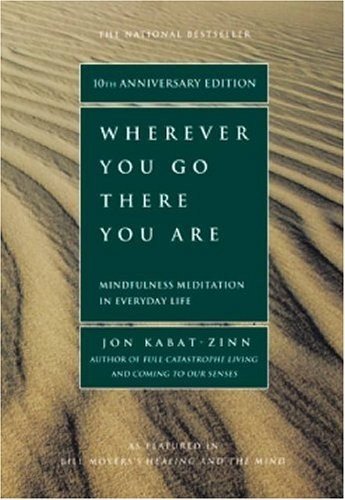I had the good fortune of making friends with long bid inmates who had taught me how to deal with my anxiety in prison. One of the first books that was recommended to me was "Wherever You Go There You Are" by by Jon Kabat-Zinn
This book is about staying mindful in our every day life. Anxiety is just fear of the future and for me this book helped me understand if I focus on the now I wont be afraid of the future.
A while back I had a lot of anxiety when I was asked to go for a random urine test. I know I did nothing wrong but I was suffering from assumed guilt. I was worried about the future and the unknown. I started awfulizing which is when I assume a catastrophic outcome in every situation.
I was recommended by an inmate and the book to try meditation. The first thing that came to mind was sitting on the floor and entering some spiritual realm that I could never achieve. I was wrong.
When we speak of meditation, it is important for you to know that this is not some weird cryptic activity, as our popular culture might have it. It does not involve becoming some kind of zombie, vegetable, self-absorbed narcissist, navel gazer, “space cadet,” cultist, devotee, mystic, or Eastern philosopher. Meditation is simply about being yourself and knowing something about who that is. It is about coming to realize that you are on a path whether you like it or not, namely, the path that is your life. Meditation may help us see that this path we call our life has direction; that it is always unfolding, moment by moment; and that what happens now, in this moment, influences what happens next.
Meditation means learning how to get out of this current, sit by its bank and listen to it, learn from it, and then use its energies to guide us rather than to tyrannize us. This process doesn’t magically happen by itself. It takes energy. We call the effort to cultivate our ability to be in the present moment “practice” or “meditation practice.”
So how can you start practicing basic meditation? I like to call this method Progressive Relaxation:
Get in a comfortable position, close your eyes and begin feeling the sense of relaxation.
Take in a big breath and bring your shoulders up towards your ears.
Now drop your shoulders and release your breathe.
Breath fresh air into your lungs, squeeze your shoulders up towards your ears and hold.... Now let your shoulders drop and relax as you release your breathe. Let the tension dissolve away.
Now clench your right fist, tighter and tighter, studying the tension as you do so. Notice the tension in your fist hand and forearm.
Relax... Let go of the tension. Feel the looseness in your hand, and forearm, and noticed the contrast with the tension. You are relaxed.
Now clench your right fist, Tighter and Tighter, studying the attention as you do so notice the tension in your face, hand, and forearm.
Relax... Let go of the tension. Feel the looseness in your hand, and forearm, and noticed the contrast with the tension. You are relaxed.
Another meditation I like to practice is deep breathing.
Although this exercise can be practiced in a variety of poses, the following is recommended: lie down on the blanket or rug on the floor. Bend your knees and move your feet about 8 inches apart, with your toes turn slightly outward. Make sure your spine is straight.
Scan your body for tension.
Place one hand on your abdomen and one hand on your chest.
Inhale slowly and deeply through your nose into your abdomen to push up your hand as much as it feels comfortable. Your chest should move only a little and only with your abdomen.
When you feel at ease with step 4, smile slightly and inhale through your nose and exhale through your mouth, make me a quiet, relaxing, watching sound like the wind as you gently blow out . Your mouth, tongue, and jaw will be relaxed. Take long, though, you press that raise and lower your abdomen. Focus on the sound and feeling of breathing as you become more and more relaxed.
Continue deep breathing for about 5 or 10 minutes out of time, once or twice a day for a couple of weeks. Then if you like, extended to 20 minutes.
One of my favorite chapters in this book taught me that we can't stop the waves of life, but we can learn to surf. There are many things in life over which we have little or no control stress is part of life, part of being human. That does not mean we have to be victims. We can learn to work with them, understanding them, find meaning in them and make critical choices. We can use them to grow up strength wisdom and compassion.
Imagine our minds as the surface of a lake or ocean. There are always waves on the water . Waves come from wind which range and intensity. Just as the Winds of stress and change cause waves in our minds. We can't fight the waves , but we can learn how to surf on them.
What are your thoughts? How do you deal with stress and anxiety? Do you awfulize situations?
-Charlie



